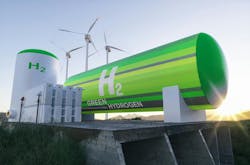Copenhagen Infrastructure Begins Work on 80K-Ton Green Hydrogen Production Plant in Germany
Copenhagen Infrastructure Partners (CIP), through its Energy Transition Fund (CI ETF I), and Friesen Elektra Green Energy AG (Friesen Elektra) have begun a green hydrogen production facility project, Anker located near Wilhelmshaven in Sande, Germany.
The project, near the future German hydrogen core network, is expected to have an electrolysis capacity of 400 MW with plans to expand it to 800 MW in the future. It is anticipated to produce 80,000 tons of green hydrogen annually to benefit German industries like steel and chemicals and the transport sector.
The project is predicted to be capable of reducing CO₂ emissions by up to 2.4 million tons annually, equivalent to the emissions of approximately 340,000 households, by replacing fossil fuels with green hydrogen.
“Project Anker has the potential to make an important contribution to Germany’s journey towards a carbon-neutral future,” said Felix Pahl, partner at CIP, in a statement. “At CIP, we continue to see a large potential in green hydrogen despite slower than expected market development and we remain committed to investments in large-scale renewable infrastructure solutions to decarbonize energy-intensive industries.
The project will create new jobs in Lower Saxony for growth and community engagement development in the region. It will be powered by renewable energy from the grid, supported by offshore and onshore wind, as well as solar energy.
Hydrogen is envisioned as a potential decarbonizing fuel for hard-to-electrify industries.
Hydrogen does not contain carbon in its molecular chain, so does not emit carbon dioxide when combusted or utilized in fuel cell technologies. Much of the world’s industrial hydrogen is generated by steam reforming which extracts the H2 out of methane gas, which is carbon intensive.
To be considered truly green hydrogen, the H2 is generated by electrolyzers which split it from water and are powered by carbon-free energy resources such as solar, wind, hydro or nuclear.
New green hydrogen projects in the U.S. include a proposed plan by startup Avina Clean Hydrogen to build a compressed H2 production site in Vernon, California, some 10 miles from the Port of Long Beach.
Track Hydrogen and other C&I Energy News
Subscribe free to EnergyTech's Transition E-Newsletter
